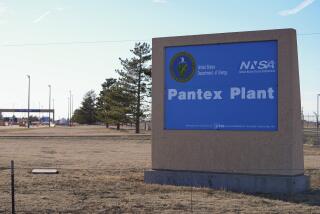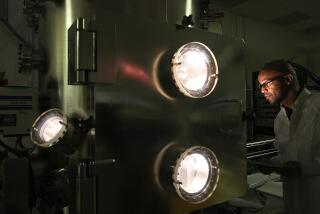Barn Door Open at the Lab
Since it was chosen as the headquarters of the U.S. atomic bomb program in 1942, Los Alamos National Laboratory has advanced science in the American interest. Recently, the lab, amid cottonwood trees on a mountain plain near Santa Fe, N.M., has competed with Lawrence Livermore National Laboratory in the Bay Area to become the headquarters of homeland security chief Tom Ridge’s counter-terrorism research program. Now, Los Alamos can probably kiss the homeland security job goodbye. Unless it acts quickly to investigate and dig out corruption, it can also say goodbye to its funding and reputation.
As Times staff writer J.R. Moehringer reported Monday, the lab’s managers recently fired two former police officers hired to investigate theft and other problems. The investigators reported unearthing a host of embarrassing security lapses, ranging from the crass (a worker who allegedly tried to buy a $30,000 customized Ford Mustang with lab money) to the dangerous (the disappearance of cryogenic freezers that could be used for bioweapons research and of 260 computers, some of which had been used for nuclear weapons design).
The lab’s problems aren’t new. Then- Energy Secretary Bill Richardson solemnly promised better security after hard drives full of nuclear data vanished from a safe in 2000. But the sweep of the current accusations is eye-opening.
Much of what is admirable about Los Alamos, managed by the University of California, lies in the lively, freewheeling atmosphere it affords scientists. During World War II, for instance, lab managers let physicist Richard Feynman pick locks throughout the property and even on one occasion remove highly sensitive documents from a supposedly secure file cabinet. It’s a good thing lab managers didn’t fire Feynman, for he went on to devise the formula for predicting the energy yield of a nuclear explosive, helping his country win the war.
Feynman’s pranks at least had a purpose: He wanted to show that the lab’s security was not nearly as infallible as its security managers had thought. The managers of Los Alamos today seem more bent on damage control than self-improvement.
They will soon come under the hard gaze of congressional investigators and get a grilling at hearings in the House Committee on Energy and Commerce. UC President Richard Atkinson shouldn’t wait for hearings, however, to dismiss the officials responsible for firing the bearers of bad news.
Investigations at Los Alamos have run off the tracks in the past, most recently in the spying accusations that led to the jailing of physicist Wen Ho Lee, who later was released. That doesn’t mean some of the lab’s nonscientist employees, the group fingered by the investigators, should be free to walk off with the furniture. As one of the dismissed investigators reasonably asked, “If you see the way they handle this money and their property, what would lead you to believe they do any better with national security?”
More to Read
Sign up for Essential California
The most important California stories and recommendations in your inbox every morning.
You may occasionally receive promotional content from the Los Angeles Times.










